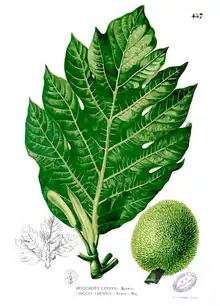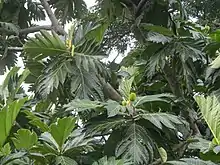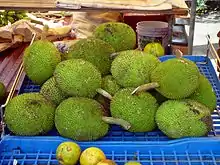Artocarpus camansi
Artocarpus camansi, the breadnut, is species of medium-sized tree in the family Moraceae.[1] It is native to New Guinea, the Maluku Islands, and the Philippines.[2] It is the wild ancestor of the breadfruit (Artocarpus altilis) and is also sometimes known as the seeded breadfruit, to distinguish it from its mostly seedless descendant. Breadnut fruits are edible when cooked. The large seeds can also be roasted and eaten.[2][3]
| Artocarpus camansi | |
|---|---|
 | |
 | |
| Artocarpus camansi tree in Nueva Ecija, Philippines | |
| Scientific classification | |
| Kingdom: | Plantae |
| Clade: | Tracheophytes |
| Clade: | Angiosperms |
| Clade: | Eudicots |
| Clade: | Rosids |
| Order: | Rosales |
| Family: | Moraceae |
| Genus: | Artocarpus |
| Species: | A. camansi |
| Binomial name | |
| Artocarpus camansi | |
| Synonyms[1] | |
|
Artocarpus leeuwenii Diels | |
History
The species was first described in Flora de Filipinas. Según el sistema sexual de Linneo (1837) by the Spanish friar and botanist Francisco Manuel Blanco from specimens in the Philippines. The specific name is derived from Tagalog kamansi (Philippine Spanish: camansi), a local name for the tree in the islands.[4]
Other common names for plant include chataigne, castaña 'tropical' (French and Spanish for the unrelated but culinarily similar chestnut), kapiak in New Guinea, katahar in Guyana, kluwih in Indonesia, sukun biji in Malaysia, kos-del (කොස්දෙල් ) in Sri Lanka, pan de fruta in Dominican Republic (Spanish for its relative breadfruit), labapin in Haïti, and pana de pepita in Puerto Rico.[2]
Distribution and origins
Artocarpus camansi is likely endemic to New Guinea, the Maluku Islands, and the Philippines.[2] The ambiguity of the origins of this plant is a result of spread and domestication of multiple species of breadfruit, Artocarpus camansi included, as Austronesian sailors spread from island to island in the Pacific. The breadfruit, Artocarpus altilis, is believed to be a domesticated descendant of Artocarpus camansi which have been selectively bred to be predominantly seedless by Polynesians.[5][6]
Habitat and ecology
Breadnut trees can usually be found in tropical environments along low-lying areas at an elevation of 0–1,550 m (0–5,085 ft), inundated riverbanks, and in freshwater swamps.[2] The plant grows best at a mean annual temperature of 15–40 °C (59–104 °F) in deep, well drained soil with a neutral to alkaline soil acidity.[2][7]
Morphology, flowers and fruit

The morphology of the breadnut is a tree up to 35 m (115 ft) tall with leaves 40–60 cm (16–24 in) long and 25–45 cm (9.8–17.7 in) wide and are pinnately lobed.[7] The plant is monoecious and the male and female flowers occur at the tips of branches. Each male flower has two anthers, and is 3 cm (1.2 in) in diameter and 25–35 cm (9.8–13.8 in) long. Additionally, each male flower is club-shaped, thousands of them grouped together in an inflorescence.[2]
The fruit is globular, weighing 800 g (1.8 lb) and are 16–20 cm (6.3–7.9 in) long by 8–15 cm (3.1–5.9 in) wide with a yellow-green color and each mature tree can produce 600–800 fruits per year.[2][7] Additionally, when ripe, the interior of the fruit is off white with a sweet taste and aroma. The fruit of the breadnut is mostly seed and the number of seeds per fruit can range from 12 to 150 per fruit at a mass of around 7–10 g (0.25–0.35 oz) per seed. The seed of the fruit are normally spread by flying fox and other mammals.[2]
Artocarpus camansi can be distinguished from the closely related Artocarpus altilis by having spinier fruits with numerous seeds. Artocarpus mariannensis can be distinguished by having dark green elongated fruits with darker yellow flesh, as well as entire or shallowly lobed leaves.[2]
Food and economic value
Artocarpus camansi is described as having "high nutritive value but it is an under-utilised food source".[3] Although not as commonly eaten as the breadfruit, it is an important crop in New Guinea, where the breadnut is a staple crop. Usually the fruit is consumed when it is immature; thinly sliced pieces are boiled in soups.[2] In the Philippines (along with the related breadfruit, jackfruit, and antipolo) it is commonly cooked with coconut milk and spices and eaten as ginataang kamansi.[8] In South Asia and the Caribbean it is curried and eaten. The seeds are also of economic value in the Caribbean, Central and South America because they taste like chestnuts. As a result, the seeds can be roasted, canned, or processed into paste, butter, flour or oil.[2]
See also
- Domesticated plants and animals of Austronesia
- Brosimum alicastrum, another plant also commonly known as "breadnut".
References
- "Artocarpus camansi Blanco". Plants of the World Online. The Trustees of the Royal Botanic Gardens, Kew. n.d. Retrieved August 23, 2020.
- Ragone, Diane (April 2006). Elevitch, C.R. (ed.). "Artocarpus camansi (breadfruit), ver.2.1" (PDF). Species Profiles for Pacific Island Agroforestry. Permanent Agriculture Resources (PAR), Hōlualoa, Hawai‘i. Retrieved 18 April 2012. <http://www.traditionaltree.org>.
- Roberts-Nkrumah, Laura B. (2005). "Fruit and seed yields in chataigne (Artocarpus camansi Blanco) in Trinidad and Tobago". Fruits. Cambridge University Press. 60 (6): 387–393. doi:10.1051/fruits:2005044. Retrieved 2012-04-18.
- Blanco, Francisco Manuel (1837). Flora de Filipinas :segun el sistema sexual de Linneo. Manila: Imprenta de Sto. Tomás por D. Cándido López.
- Zerega, Nyree J. C.; Diane Ragone; Timothy J. Motley (2004). "Complex Origins of Breadfruit (Artocarpus altilus, Moraceae): Implications for Human Migrations in Oceania". American Journal of Botany. 91 (5): 760–766. doi:10.3732/ajb.91.5.760. PMID 21653430. Retrieved 18 April 2012.
- Ragone, Diane (2011). "Farm and Forestry Production and Marketing Profile for Breadfruit (Artocarpus altilis)". In Elevitch, Craig R. (ed.). Specialty Crops for Pacific Island Agroforestry. Permanent Agriculture Resources. ISBN 978-0970254481.
- Zerega, Nyree J. C.; Diane Ragone; Timothy J. Motley (2005). "Systematics and Species Limits of Breadfruit (Artocarpus, Moraceae)". Systematic Botany. 30 (3): 603–615. doi:10.1600/0363644054782134.
- "Ginataang Kamansi/ Seeded Breadfruit in Coconut Milk". The Peach Kitchen. Retrieved 19 April 2019.